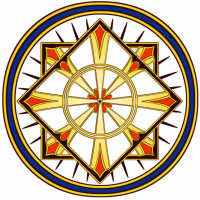Cosmology
 Dak
🖼️ 37 images Surveyor
Dak
🖼️ 37 images Surveyor
Here is the star system for my campaign world. Once again, this is not new material but was created in the early 90's. It's so great to able to depict it in a dedicated program, because the original version using circles in Microsoft Excel just doesn't compare.
Looking at the map though makes me want to go spelljammimg this weekend.
Tagged:







Comments
Looks good, but I am wondering a bit about your usage of scale here. A lot of the map is left blank which I assume is to keep things scaled, yet that sun is absolutely tiny. And the innermost gas giant seems to orbit real close to those planets there, looks like it is really going to mess with their orbits and tidal forces, being a major competitior to the sun.
I know astronomical scale is hard when you try to make an illustrative map though, but those things kind of caught my eye.
I totally agree with your assessment Monsen.
The planets orbits are to scale relative to each other. The planets though are representative of their size relative to each other.
I know there are things in the map that are stretching physics a lot, but it is a star system randomly rolled using the spelljammer rules from 2nd edition. Because of that I do have the info' for the size of each planet, its distance from the star, how long a day is on each planet, and how long it takes the planet to complete an orbit, amongst a couple of other details. For instance Taia (the campaign world) is 81 Mil' km from the star and a year is 364 days (12 months of 30 days and 4 special days which are the solstices and equinoxes). This calendar also fits a lunar calendar of 13 months of 28 days, which in my game world is the elven and druidic calendar.
When I finished the map I had the same thoughts about the inner gas giant, in that a Jupiter sized planet that close to the other planets would cause major 'anomalies' in their orbits, and the closest planet would probably be orbiting the gas giant and not the star (which might make an interesting looking map in its own right). Comparing it to our solar system it seems like the gas giants don't have enough moons, but placing 70 or so moons and naming them is not going to happen.
Also, I made the orbits circular, just for ease, as I was struggling to get good looking elliptical orbits. It also reminded me though of those old woodcut pictures of the 15th and 16th centuries where the sun/earth is depicted in the middle of the map and the known planets are placed in circles around the central body. So I thought what the hell, it reminds me of how a medieval society may portray their solar system so go with it.
The gas giants are supposed to have rings but I couldn't find a decent way of depicting this. Any help with this would be appreciated.
When I needed to add rings for a couple of the planets on the Nibirum Solar System Chart for the Community Atlas, I just used angled lines of a suitable thickness to be seen still, and the line-length correct to-scale for their sizes compared to the planetary discs. As the Cos3 planet symbols with belts in the atmosphere are seen side-on, this seemed a suitable compromise.
It would be possible to go for a more artistic endeavour, showing the rings partly open, but this will occupy more space on the drawing, and I had enough problems just fitting the lines on my effort! It will also make a mess of showing the planetary moons as you have them now, of course.
Thanks Wyvern. I just checked your maps out, they look awesome. I have a long way to go to match yours, magnificent. The rings around the planets from the perspective of looking down on them just look amazing.
As I said above, I do have some stats for the planets because of the spelljammer rules, I need to find a format to present them that looks OK. The names of the planets and moons are from my world's mythology. The majority are names of the titans who were defeated by the gods before recorded history, most of whom are now imprisoned in Malados in the underworld, a huge volcano guarded by Ti-Amat.
Thanks very much! CC3+ does most of the "heavy lifting" for you when drawing maps of any sort, of course, and it helps to have a familiarity with how ringed planets look in our own Solar System (Saturn particularly, obviously enough). The one downside from the detailed maps is that you don't get polar-view planetary symbols in Cos3, which is something worth considering drawing for your own mapping, perhaps, for the gas giants.